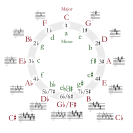調號
外觀

調號(德語:Vorzeichen,法語:Armure,英語:Key signature)是五線譜記譜法中寫在譜號後面的變音記號,亦即標記在譜號後面的升、降號。
調號用來標註需要升高或者降低的音符[1],並且一個升降號會影響同一行譜表中多有同音名的音符,所以不用在相同音名的不同線上都標記出升降號[2]。
每個大調和小調的樂曲中都會按照調號標記的方式來升高或降低每個音符,然而也有特殊情況,例如一些巴洛克作品[3] ,或是一些在傳統的民歌曲調[4]。
產生
[編輯]
調號的產生和音階的結構有着緊密的關係,例如C大調音階中相鄰的音的全音、半音關係與高低譜號表線上的C、D、E、F、G、A、B、C各音的音高一一對應,所以以C為主音的大音階是不需要升降號的,亦即與鋼琴上白鍵的排列完全吻合[5]。
以C大調音階上的屬音(G)為新的主音,為符合大音階的結構規律,則必須升高F音,然後把F音上的升號移到譜號後面,即產生了一個升調的調以及這個調(G大調)的調號。依此方法,若以G大調音階上的屬音做為主音可以得到D大調音階[6]。
理論上,一段音樂可以用任何調號記譜,但不適當選取調號會使譜面出現過多不必要的變音記號而難以閱讀。下面兩張圖分別是用C大調和B大調的調號下的B大調音階:
B大調的調號下的B大調音階,所有升號被「移」至左側高音譜號旁。
調號一覽
[編輯]五度圈
[編輯]
表格
[編輯]
|
參考文獻
[編輯]- ^ Kraus, Herbert. Das große Buch der Musiktheorie. Bonn: Voggenreiter Verlag, 2012. Seite 28. ISBN 978-3-80240-936-3
- ^ Bartel, Frank. Musiktheorie endlich verstehen. Berlin: Leu-Vlg Wolfgang Leupelt, 2015. Seiten 6-18. ISBN 978-3-89775-155-2
- ^ Schulenberg, David. Music of the Baroque. New York: Oxford University Press, 2001. p. 72.. "(…) to determine the key of a Baroque work one must always analyze its tonal structure rather than rely on the key signature."
- ^ Cooper, David. The Petrie Collection of the Ancient Music of Ireland. Cork: Cork University Press, 2005. p. 22. "In a few cases Petrie has given what is clearly a modal melody a key signature which suggests that it is actally in a minor key. For example, Banish Misfortune is presented in D minor, although it is clearly in the Dorian mode."
- ^ Kühn, Clemens. Musiktheorie unterrichten - Musik vermitteln. Dresden: Bärenreiter, 2006. Seiten 31-48. ISBN 978-3-76181-835-0
- ^ Charritat. Theorie de la Musique. Paris: Henry Lemoine, 2014. pp. 19-34. ISBN 979-0-23099-142-1

















